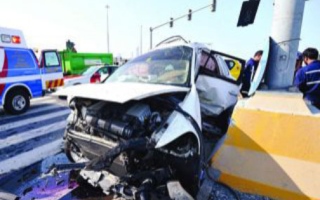- City Fajr Shuruq Duhr Asr Magrib Isha
- Dubai 05:15 06:31 12:06 15:11 17:35 18:51
Conocarpus Erectus, or ‘Damas’ as the tree is called in Arabic, is one of the most popular foliage choices in any Dubai residential garden.
However, what may seem an innocent seed can grow out to become a monster.
The Damas tree grows fast, looks bright-green and provides a lot of shade.
It has a high salt- and drought-tolerance and thrives exceptionally well in a hot city climate.
It is no wonder that this tree is one of Dubai’s favorites.
“People who are not from this region have no idea what the consequences of planting this tree may be,” says a gardener of Dreams Flower Co, in the green business for the past 13 years.
The Parks and Horticulture Department of Dubai Municipality launched a campaign earlier this year after receiving 240 reports of the tree causing harm in different parts of the emirate.
“The problem that this tree currently poses is that its roots have the ability to break into water and sanitation systems, grow inside these systems forcing them into strange shapes, which prevents the water from entering the house,” explains Ahmad Mohammad Abdul Kareem, Director of the Department.
As soon as the tree has reached the maturity of one month, roots can grow into same lengths below the ground as the rest of the tree above the ground.
These enormous roots are strong, aggressive and in search for any source of water. In order to get to this source, nothing is in their way.
"Many landscapers do not know how to plant these trees," says Sadam Hussein, production manager at Desert Group.
"Sometimes they plant it near kitchens, toilets or swimming pools, where this plant can sense the water availability and direct its roots to that direction, which can damage walls and other material."
According to Sadam, the tree should be a public area tree only. "The tree could be planted in private gardens only to function as a border, or fence.
“We normally sell around 15-20 thousand trees a year. And we receive orders for removal too, but from people who had the tree planted in the wrong place."
The Parks and Horticulture Department aims to solve the problem by implementing a short- and long-term plan.
“The short-term plan aims towards the removal of those garden trees that were reported as problematic, in addition to planting alternative trees that are more suitable for the home garden and do not cause problems in the long run,” explains Ahmad.
For the long-term plan Dubai Municipality reaches out to the public to raise awareness, providing guidance and education as to what the right choice of tree would be for a home garden.
Until now Dubai’s residents have learnt the hard way.
Many residential compounds in Arabian Ranches, Meadows, Springs, Jumeirah Village and Silicon Oasis have fallen victim to the intrusive roots of the innocent looking tree.
“The roots of this tree have reached the pipes of my bathtub, and the bathtub may need to be taken out entirely,” says Elizabeth Hoffman, a resident in Arabian Ranches.
“Once the water find its way out, the leak may affect the foundation of the villa and the problem will even be bigger,” she says anticipating a high bill for damage control.
When acting simultaneously, Damas trees can topple a wall. The ground they penetrate often turns into a hilly craterlike landscape.
Once they found their way to the sought for water source, leakage may indeed be the result, and resident are heard complaining of increased Dewa bills.
Unfortunately, removal of the Damas tree is not a simple procedure. Both, the tree and roots, need to be taken out entirely to stop its biological activity and prevent roots from growing further, causing negative effects, tells Ahmad.
Since the launch of the campaign a team of experts has visited 41 sites of the 240 that were reported, and gardeners receive removal requests for the Damas tree all the time.
“We have removed thousands of these trees in residential areas of Dubai,” says the gardener of Dreams Flower Co.
“We try to tell people about the dangers before the trees are planted, but often we are not taken seriously.
“We are still asked to plant the trees. At the same time we are asked by many people to remove them,” he adds.
“The Parks and Horticulture Department always supports efforts towards increased greenery and its maintenance, however, it has learnt from the experience of the past, when residents of Al Safa, Al Wasl and Al Bada’a were undergoing similar problems with the Eucalyptus and Camphor trees,” says Ahmad.
“Although these trees were growing rapidly and proved suitable as a wind buffer, they turned out to be eager water absorbers with horizontally extending roots that blocked the sewerage system and caused walls to crack.
“Therefore, we must address the problem in an integrated manner to ensure that it does not recur in the future.”
MUST READ:
Jumping red lights kills three, injures 11 in Abu Dhabi

Remittance of savings ‘tax-free’, for UAE Indian expats, clarified

Dh299 XPad tablet to hit UAE stores on July 18
![]() Follow Emirates 24|7 on Google News.
Follow Emirates 24|7 on Google News.